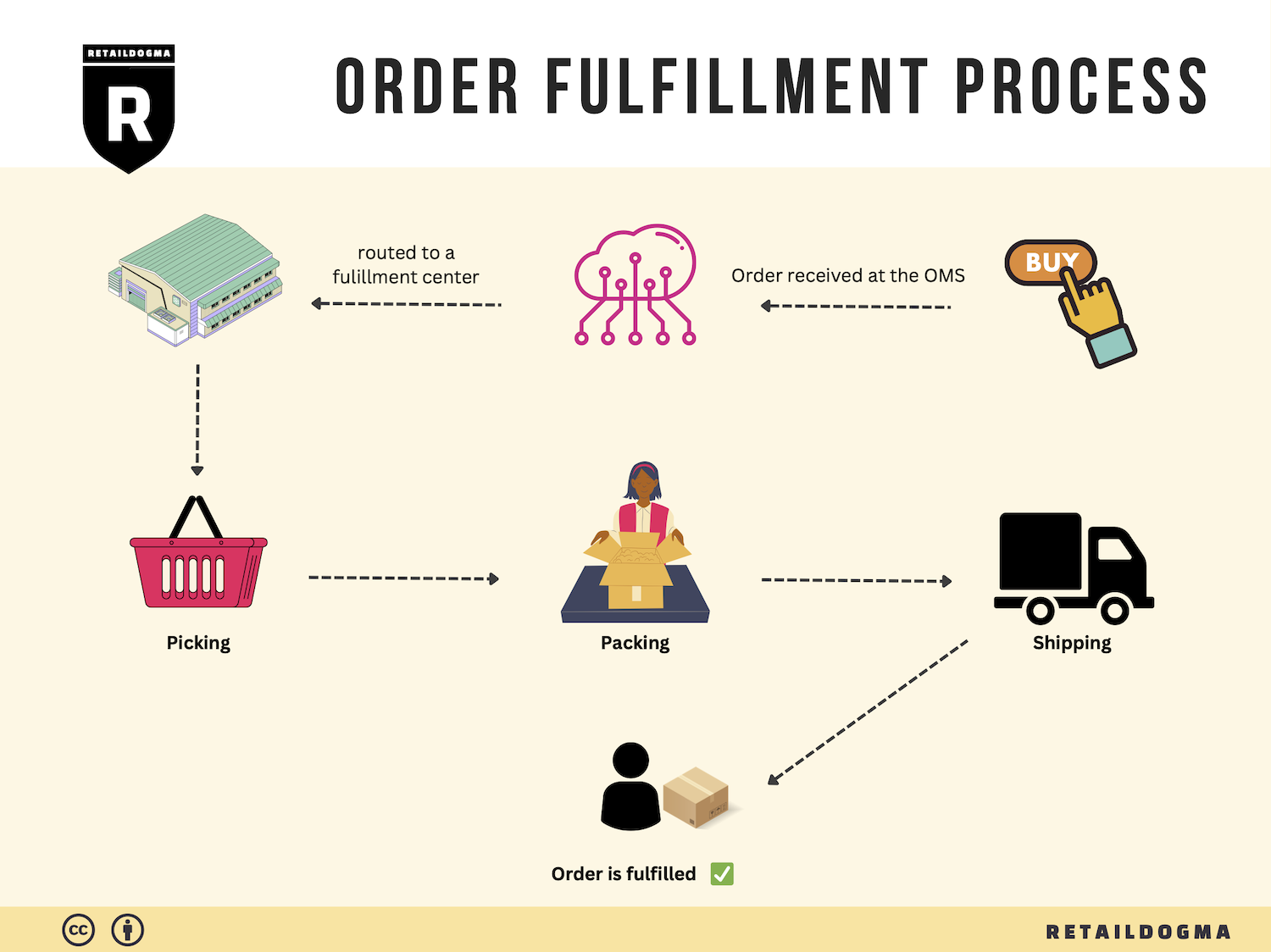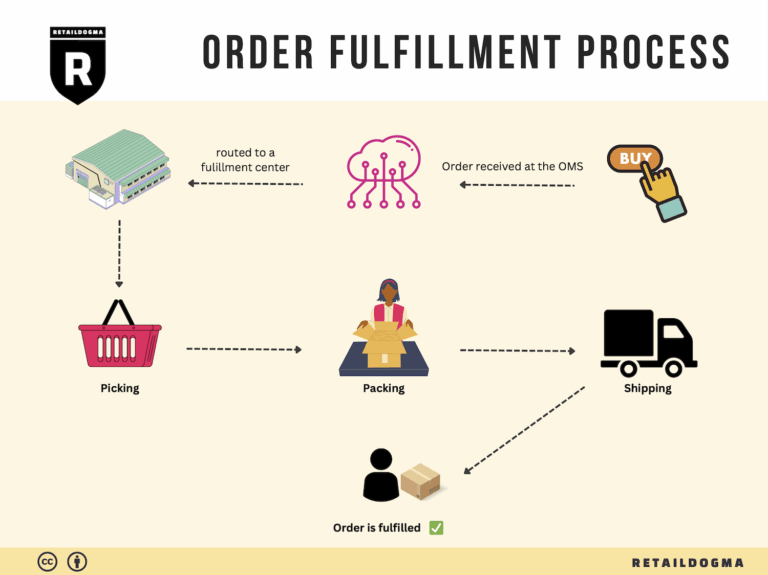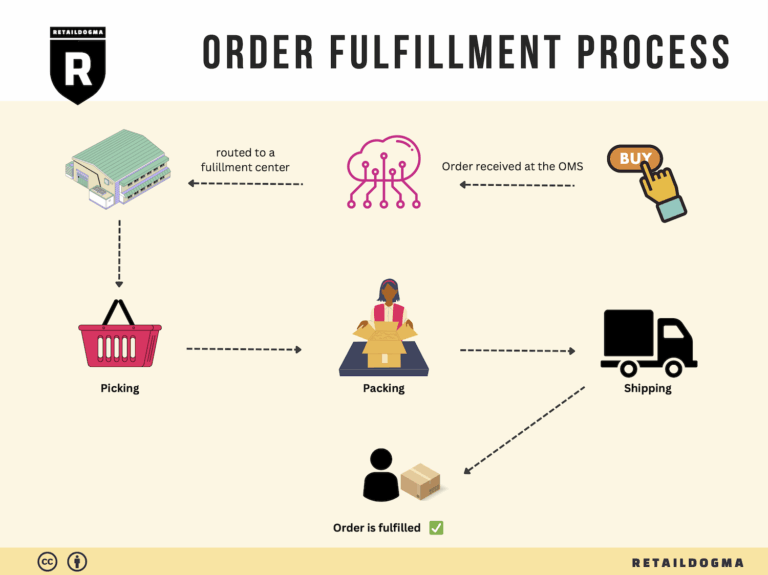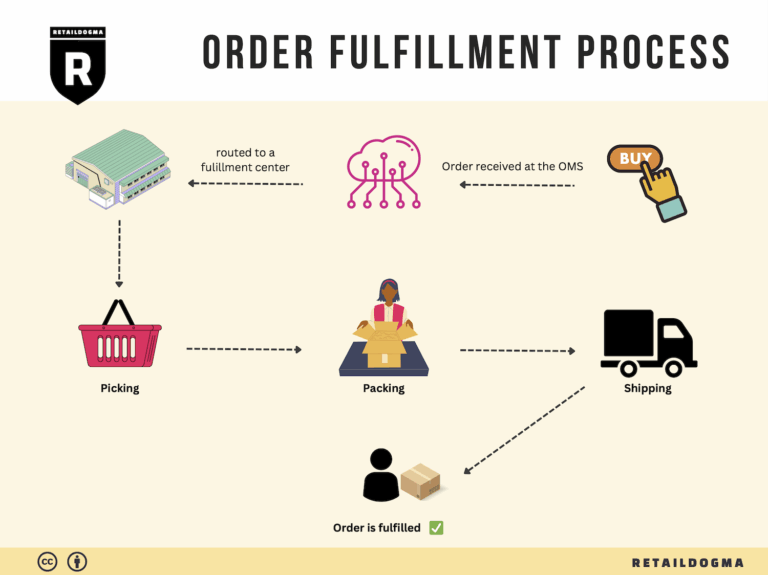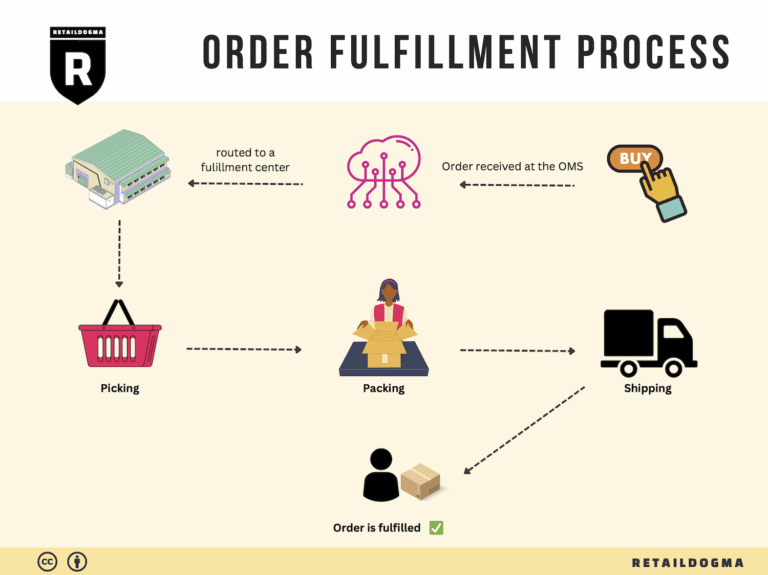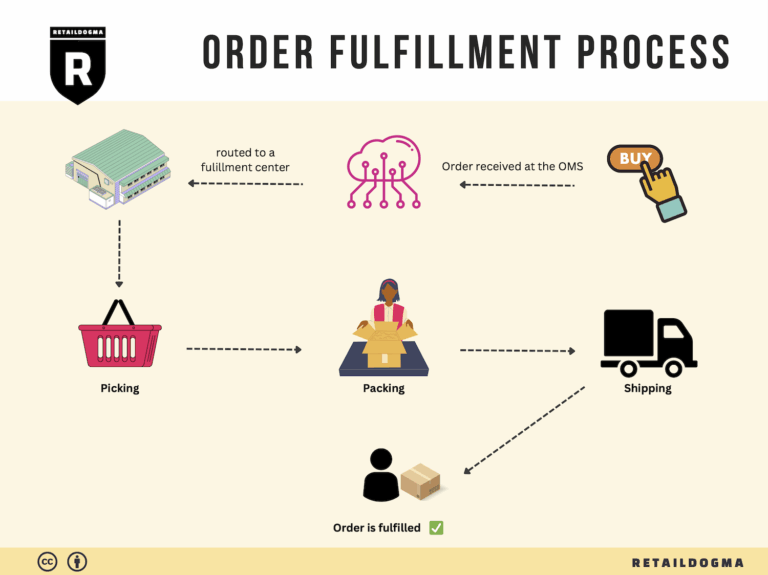How Order Fulfillment Works: A Step-by-Step Guide for Businesses
What is E-commerce Fulfillment? An Introduction for Growing Businesses
Understanding E-commerce Fulfillment: A Key to Scaling Your Business
As a growing online business owner, you may find yourself overwhelmed with the logistics of packing and shipping orders. The excitement of making sales can quickly diminish when faced with the complexities of fulfilling those orders efficiently and accurately. This is where e-commerce fulfillment comes into play—a critical process that encompasses all steps involved in getting a product from your warehouse to your customer’s doorstep.
At its core, e-commerce fulfillment is the systematic approach to managing inventory, processing orders, and ensuring timely delivery. It involves various stages, including receiving inventory, storing products, picking and packing orders, shipping them to customers, and handling returns. The effectiveness of this process can significantly impact customer satisfaction and ultimately your business’s growth.
In this guide, we will explore different fulfillment models that can cater to your business needs, such as Third-Party Logistics (3PL) and Fulfillment by Amazon (FBA). Each model has its unique benefits and challenges, and understanding these can help you make informed decisions about the best approach for your operation.
We will also delve into the core services associated with e-commerce fulfillment, including inventory management, order processing, kitting, and custom packaging. Knowing what services are available will enable you to tailor your fulfillment strategy to align with your brand’s goals and customer expectations.
Selecting the right fulfillment partner is crucial for your success. We will provide practical tips on evaluating potential partners, considering factors like technology integration, shipping capabilities, customer service, and pricing structures. This section aims to guide you through the decision-making process, ensuring you choose a partner that complements your business model and enhances your operational efficiency.
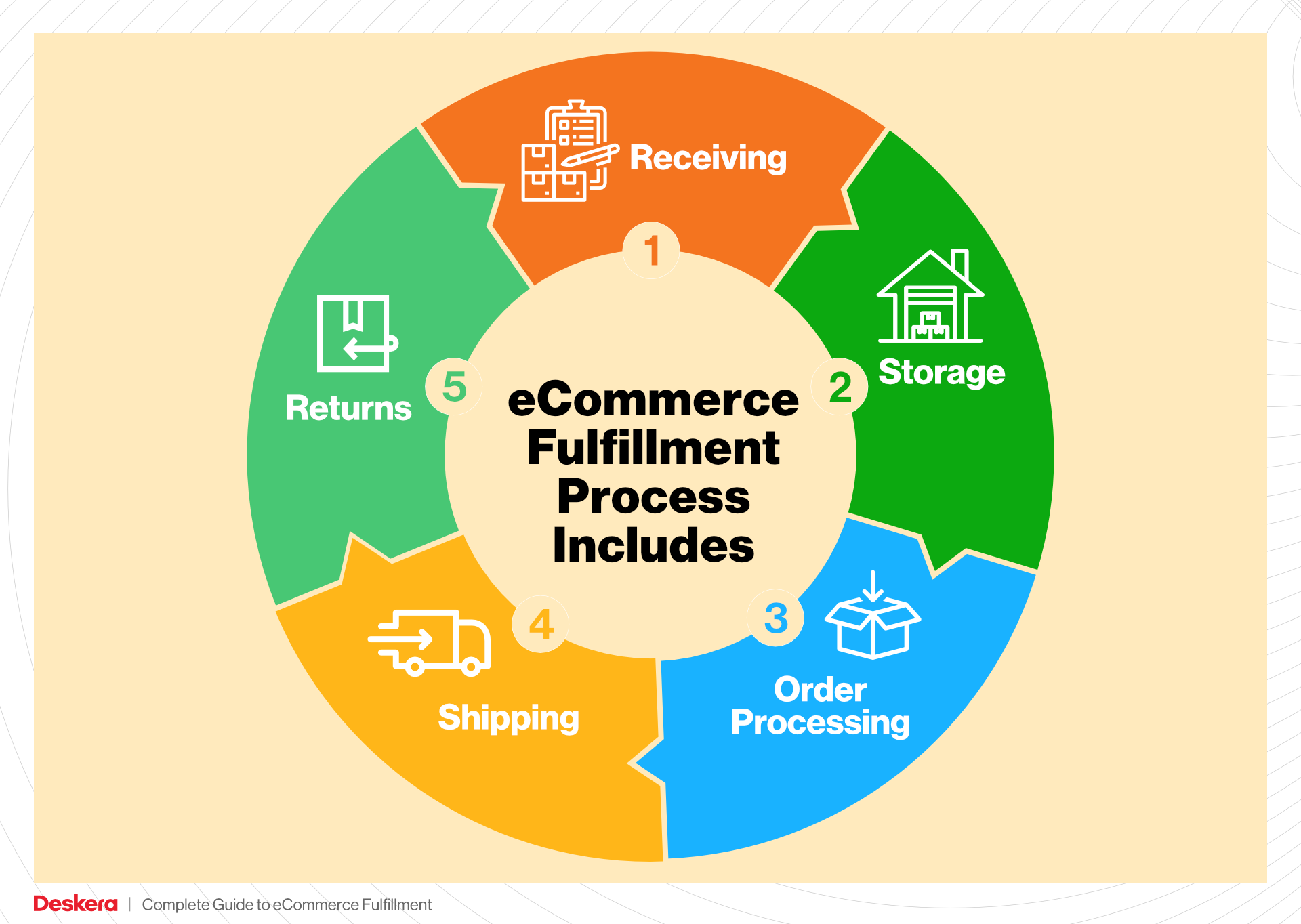
Finally, we will address pricing strategies related to fulfillment services. Understanding how pricing works and what factors influence costs will empower you to negotiate better terms and manage your budget effectively.
The goal of this guide is to equip you with the knowledge and insights needed to make smart decisions about your logistics. By optimizing your fulfillment process, you can focus on scaling your sales and providing exceptional experiences for your customers, ultimately driving your business forward.
What You’ll Learn In This Guide
- What is E-commerce Fulfillment? An Introduction for Growing Businesses
- The Order Fulfillment Process: From ‘Buy’ Button to Customer’s Door
- Comparing Fulfillment Models: In-House vs. 3PL vs. Dropshipping
- A Deep Dive into Amazon FBA: Pros, Cons, and Who It’s For
- Core Services Offered by Fulfillment Centers
- How to Choose a Fulfillment Partner: A 6-Point Checklist
- Understanding Fulfillment Pricing: A Breakdown of Common Fees
- Frequently Asked Questions (FAQs) about Fulfillment
- Conclusion: Is Outsourcing Fulfillment the Right Move for Your Business?
- Important Disclaimer
The Order Fulfillment Process: From ‘Buy’ Button to Customer’s Door
1. Receiving Inventory
The first step in the order fulfillment process is receiving inventory into your warehouse. When products arrive from suppliers, they must be checked for accuracy and quality against the purchase orders. This is crucial to ensure that the right items, quantities, and conditions are met before they enter your storage system.
During this phase, key terms such as Stock Keeping Units (SKUs) come into play. Each product is assigned a unique SKU, which helps in tracking inventory throughout the fulfillment process. Efficient receiving procedures reduce the chances of errors, which can lead to stock discrepancies and impact customer satisfaction.
Having a robust system in place for receiving inventory not only enhances operational efficiency but also sets the tone for the accuracy of subsequent steps. Proper documentation and quality checks at this stage can save significant time and resources later on, ultimately contributing to a smoother fulfillment process.
2. Warehouse Storage
Once inventory is received, it is stored in a designated area of the warehouse. The organization of this storage is vital; it directly affects the speed and efficiency of the fulfillment process. Effective warehouse management systems (WMS) categorize products based on various factors such as size, weight, and demand frequency.
Proper storage strategies, including the use of pallet racking and shelving systems, maximize space and facilitate easy access to products. This is where concepts like First-In-First-Out (FIFO) and Last-In-First-Out (LIFO) come into play, particularly important for managing perishable goods or items with expiration dates.
Well-organized storage not only enhances the speed of order picking but also minimizes the risk of damage to inventory. An efficient storage system can lead to reduced labor costs and improved order fulfillment times, making it a critical component of the overall logistics operation.
3. Order Picking
Order picking is the process of retrieving items from their storage locations to fulfill customer orders. This step is often considered one of the most labor-intensive and time-consuming aspects of order fulfillment. The use of pick lists is crucial here; these documents or digital interfaces guide warehouse staff on which items to collect and their respective locations.
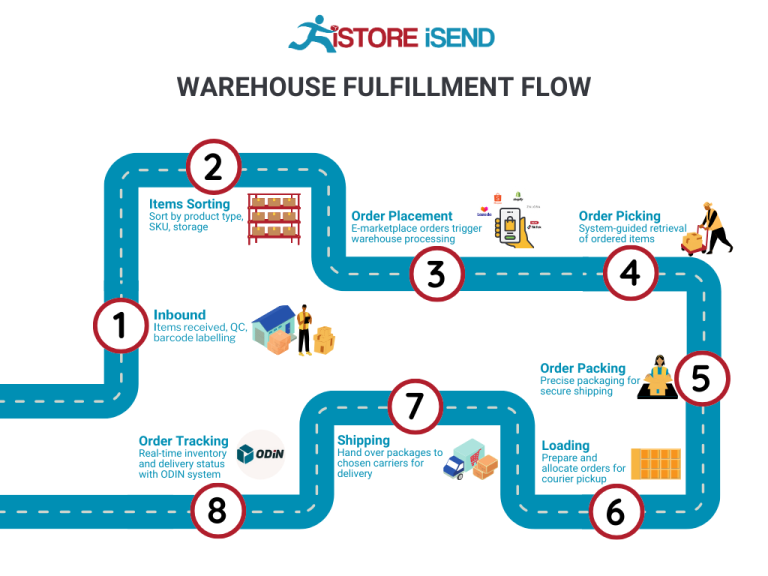
There are various picking methods, including single order picking, batch picking, and zone picking, each suited for different types of operations and order volumes. The choice of picking method can significantly impact efficiency and accuracy. For instance, batch picking allows for multiple orders to be picked simultaneously, which can speed up the process in high-volume operations.
Efficient order picking is essential because it directly influences order accuracy and fulfillment speed. Errors at this stage can lead to incorrect shipments, customer dissatisfaction, and costly returns. Therefore, investing in training and technology, such as barcode scanning systems, can enhance picking accuracy and operational efficiency.
4. Order Packing
After items have been picked, they move to the packing station. This step involves organizing and preparing the items for shipment. Packaging materials must be chosen carefully to protect the products during transit while also considering brand presentation. Customized packing can enhance the unboxing experience for customers, contributing to brand loyalty.
Key terms associated with this stage include packing slips and shipping labels, which provide essential information for both the customer and the carrier. Packing slips detail the contents of the shipment, while shipping labels include vital data such as the destination address and tracking information.
Proper packing is crucial for minimizing damage during transportation and ensuring that orders arrive as expected. A well-executed packing process can also improve shipping efficiency and reduce costs, particularly if you implement strategies like dimensional weight pricing to optimize packaging size.
5. Shipping & Delivery
The final step in the order fulfillment process is shipping and delivery. Once packages are packed, they are handed off to carriers for transportation to the customer. This stage includes selecting the appropriate shipping method based on factors like cost, speed, and customer preference.
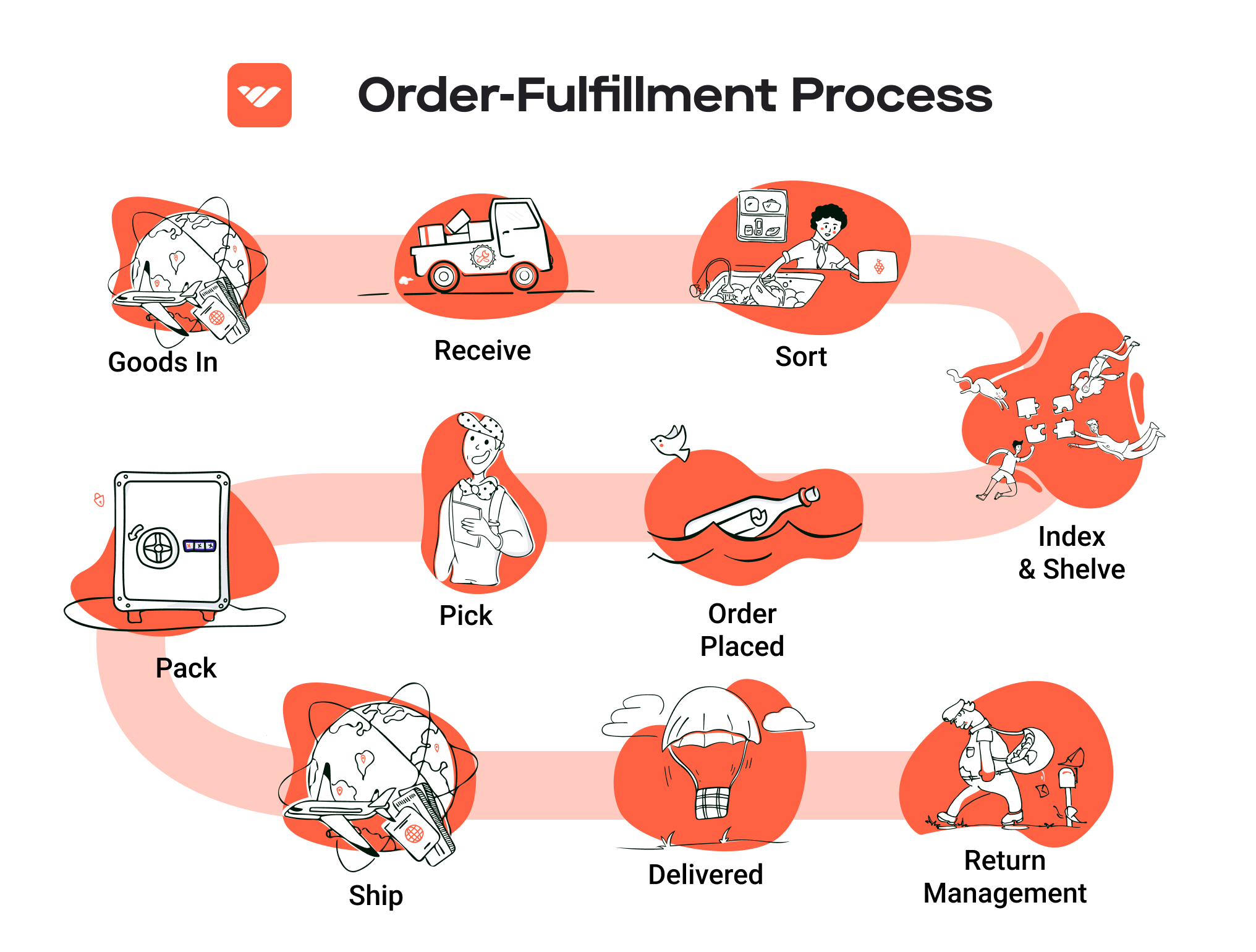
Tracking systems play a significant role here. They allow both the business and the customer to monitor the shipment’s progress, enhancing transparency and trust. Timely delivery is crucial; it is often a key factor in customer satisfaction and repeat business.
Incorporating efficient logistics strategies, such as utilizing multiple carriers or regional distribution centers, can optimize shipping times and costs. Additionally, offering various shipping options (e.g., standard, expedited) can cater to different customer needs, ultimately enhancing the overall customer experience.
In conclusion, understanding and optimizing each step of the order fulfillment process is essential for e-commerce businesses looking to scale. By focusing on receiving, storage, picking, packing, and shipping, companies can improve efficiency, accuracy, and customer satisfaction, paving the way for sustainable growth.
Comparing Fulfillment Models: In-House vs. 3PL vs. Dropshipping
Fulfillment Model Comparison
| Model | Who Handles Inventory | Best For (Business Stage) | Key Advantage | Key Disadvantage |
|---|---|---|---|---|
| In-House Fulfillment | Business Owner | Established Businesses | Complete control over operations | High overhead costs and complexity |
| Third-Party Logistics (3PL) | 3PL Provider | Scaling Businesses | Cost-effective, scalable solutions | Less control over fulfillment processes |
| Dropshipping | Supplier | Startups and Small Businesses | Low upfront investment and risk | Lower profit margins and reliance on suppliers |
In-House Fulfillment
In-house fulfillment involves managing your own inventory and logistics operations within your business. This model is often best suited for established businesses that have the resources to invest in warehousing, staff, and technology. One of the key advantages of in-house fulfillment is the complete control it provides over operations, enabling businesses to tailor processes to their specific needs and maintain strict quality assurance standards. Companies can implement personalized packing, branding, and shipping strategies, which can enhance customer experience. However, this model comes with significant disadvantages. The overhead costs can be high due to warehousing expenses, labor costs, and technology investments. Additionally, as order volumes increase, the complexity of operations grows, which may require additional staff and systems to manage effectively. This can lead to a burden on resources and may hinder scalability.
Third-Party Logistics (3PL)
Third-party logistics (3PL) providers offer outsourced fulfillment services, managing inventory, warehousing, and shipping on behalf of businesses. This model is particularly beneficial for scaling businesses that want to focus on growth without the burden of managing logistics. The key advantage of partnering with a 3PL is cost-effectiveness; businesses can leverage the provider’s infrastructure, technology, and expertise, which can lead to lower shipping rates and improved delivery times. For instance, a provider like TRG Fulfillment offers advanced warehouse management systems and high-order accuracy rates, enabling businesses to optimize their fulfillment processes. However, relying on a 3PL means relinquishing some control over fulfillment processes. Businesses may encounter challenges in communication, and any issues with the 3PL can directly impact customer satisfaction. Additionally, choosing the right partner is crucial; a poorly performing 3PL can lead to delays and errors that harm a brand’s reputation.
Dropshipping
Dropshipping is a fulfillment model where retailers sell products without holding inventory. Instead, when a customer makes a purchase, the retailer forwards the order details to a supplier, who then ships the product directly to the customer. This model is ideal for startups and small businesses that want to minimize upfront investment and risk, as it eliminates the need for inventory management and warehousing. The primary advantage of dropshipping is the low barrier to entry; entrepreneurs can start an e-commerce business with minimal capital. Additionally, it allows for a wide range of product offerings without the complexities of managing stock. However, dropshipping comes with its own set of challenges. Profit margins tend to be lower than other fulfillment methods due to reliance on suppliers, and businesses have less control over product quality and shipping times. Delays from suppliers can lead to customer dissatisfaction, and inconsistent product quality can harm a brand’s reputation. Therefore, while dropshipping can be a great entry point for many entrepreneurs, it requires careful supplier selection and customer service management to ensure success.
In summary, the choice of fulfillment model greatly depends on your business stage, resources, and strategic goals. Each model has its unique advantages and disadvantages that should be carefully considered to align with your operational capabilities and customer expectations.
A Deep Dive into Amazon FBA: Pros, Cons, and Who It’s For
Understanding Fulfillment by Amazon (FBA)
Fulfillment by Amazon (FBA) is a service offered by Amazon that enables e-commerce sellers to store their products in Amazon’s fulfillment centers. Amazon takes care of storage, packaging, shipping, and customer service, allowing sellers to focus on growing their businesses. This service is particularly beneficial for those looking to leverage Amazon’s extensive logistics network and customer base.
How FBA Works
-
Product Setup: Sellers create product listings on Amazon and specify that they want to use FBA. They prepare their products according to Amazon’s packaging guidelines and ship them to Amazon’s fulfillment centers.
-
Storage: Once received, Amazon stores the products in its warehouses. Inventory is tracked in real time, and sellers can monitor stock levels through their Amazon Seller Central account.
-
Order Fulfillment: When a customer places an order, Amazon picks, packs, and ships the product on behalf of the seller. The product is typically shipped using Amazon’s logistics network, which is known for its speed and efficiency.
-
Customer Service: Amazon also handles customer service and returns for FBA orders, which can save sellers considerable time and effort.
-
Payment: After the sale, Amazon deducts fees associated with storage and fulfillment from the seller’s account before transferring the remaining revenue.
Pros of Using FBA
1. Prime Eligibility
One of the most significant advantages of FBA is that products become eligible for Amazon Prime. This means that Prime members can enjoy benefits such as free two-day shipping. The Prime badge can significantly enhance a product’s visibility and attractiveness, leading to increased sales.
2. Enhanced Customer Trust
Products fulfilled by Amazon often enjoy a higher level of trust from customers. Amazon is known for its reliable service, and customers are more likely to purchase items that are backed by Amazon’s fulfillment process. This can lead to higher conversion rates and fewer abandoned carts.
3. Multi-Channel Fulfillment
FBA allows sellers to fulfill orders from various sales channels, not just Amazon. This means that if a seller has a Shopify store or sells on eBay, they can still use FBA to handle the logistics. This multi-channel fulfillment capability simplifies operations for sellers with diverse sales platforms.
4. Time Savings
By outsourcing logistics to Amazon, sellers can save considerable time. They don’t have to worry about inventory management, packing, or shipping. This allows them to focus on other essential aspects of their business, such as marketing and product development.
5. Scalability
FBA provides a scalable solution for growing businesses. As sales increase, sellers can rely on Amazon’s infrastructure to handle increased order volumes without the need for significant investment in warehousing or logistics.
Cons of Using FBA
1. High Fees
FBA comes with a variety of fees, including storage fees for inventory held in Amazon’s warehouses and fulfillment fees for each order shipped. These costs can add up quickly, especially for sellers with low-margin products. It’s essential for sellers to carefully calculate their costs to ensure profitability.
2. Strict Inventory Rules
Amazon has stringent inventory management policies, including limits on the amount of inventory sellers can send to fulfillment centers. These rules can restrict the flexibility of sellers, especially those with fluctuating demand or seasonal products.
3. Commingling Risks
FBA uses a commingling system where inventory from different sellers may be stored together. This can lead to issues if a seller’s product is damaged or misrepresented due to another seller’s inventory. Sellers may face challenges in ensuring that their products are not affected by the quality or mismanagement of others.
4. Loss of Control
When using FBA, sellers relinquish some control over their fulfillment process. This includes aspects like packaging and branding. Sellers may find that their products are not packaged in a way that aligns with their brand identity, which can be a concern for those focused on customer experience.
Who is FBA Best For?
Fulfillment by Amazon is particularly well-suited for:
-
Small to Medium-Sized Businesses: Sellers who do not have the resources to manage warehousing and logistics can benefit significantly from FBA’s streamlined process.
-
Brands Seeking Visibility: Businesses looking to tap into Amazon’s extensive customer base and leverage Prime membership will find FBA advantageous for increasing sales.
-
Sellers with High-Volume Products: Those with products that have consistent demand can benefit from FBA’s efficiency and scalability, allowing for more significant sales without the hassle of managing logistics.
-
Multi-Channel Sellers: Brands that sell across various platforms can streamline their operations with FBA, allowing them to manage fulfillment from a single source.
In conclusion, while Fulfillment by Amazon offers significant advantages, such as increased visibility, customer trust, and operational efficiency, sellers must also weigh the associated costs and potential risks. Careful consideration of these factors will help businesses determine if FBA aligns with their growth objectives and operational capabilities.
Core Services Offered by Fulfillment Centers
Inventory Management & Warehousing
Effective inventory management is the backbone of any successful e-commerce operation. Fulfillment centers provide dedicated warehousing solutions that allow businesses to store their products securely and efficiently. This service typically includes real-time inventory tracking, which helps e-commerce businesses maintain optimal stock levels, prevent stockouts, and reduce excess inventory.
The benefits of robust inventory management are multifaceted. First, it minimizes the risk of overstocking or understocking, which can lead to lost sales or increased holding costs. Second, with integrated Warehouse Management Systems (WMS), businesses gain access to valuable data analytics that can inform purchasing decisions and sales strategies. This not only streamlines operations but also enhances customer satisfaction by ensuring that products are available when customers want them.
Additionally, fulfillment centers often utilize strategic locations to facilitate faster shipping. By situating warehouses near major transportation hubs, they can significantly reduce shipping times and costs, thereby improving the overall customer experience. This geographical advantage is particularly beneficial for businesses looking to scale quickly while maintaining high service levels.
Pick and Pack Services
Pick and pack services are essential for e-commerce businesses looking to streamline their order fulfillment process. This service involves the selection (picking) of items from the warehouse based on customer orders, followed by packing these items securely for shipment. Fulfillment centers typically employ advanced technology and efficient processes to ensure that this operation is both accurate and speedy.
The primary benefit of pick and pack services is the efficiency it brings to order fulfillment. By outsourcing this process to a fulfillment center, e-commerce businesses can focus on core activities such as marketing and product development, while leaving the logistics to experts. A high accuracy rate in picking—often upwards of 99%—reduces the likelihood of shipping errors, which can lead to customer dissatisfaction and increased return rates.
Moreover, fulfillment centers often offer customizable packing options, allowing businesses to enhance their brand image through tailored packaging solutions. This not only protects the products during transit but also adds a personal touch that can enhance customer loyalty and satisfaction.
Kitting and Assembly
Kitting and assembly services are increasingly important for e-commerce businesses that offer bundled products or require pre-assembly for their goods. This service involves grouping individual items together to create a single, ready-to-ship kit, or assembling components to form a finished product. Fulfillment centers typically have specialized areas and skilled staff to handle these operations efficiently.
The benefits of kitting and assembly are significant. For businesses, this service reduces the time and labor involved in preparing products for sale, allowing them to focus on scaling their operations. It also enables businesses to offer unique product bundles that can drive sales and improve customer engagement. For example, a beauty brand might offer a skincare kit that combines several products, increasing the perceived value and convenience for the customer.
Additionally, by outsourcing kitting and assembly, businesses can reduce overhead costs associated with in-house labor and equipment. Fulfillment centers often have the capacity to handle high volumes, which can be particularly advantageous during peak seasons or promotional events.
Returns Management (Reverse Logistics)
Returns management, or reverse logistics, is a critical service offered by fulfillment centers that can greatly enhance an e-commerce business’s operational efficiency. This service encompasses the processes involved in handling product returns, including inspection, restocking, and managing customer refunds or exchanges.
The benefits of effective returns management are particularly relevant in the e-commerce landscape, where return rates can be significantly higher than in traditional retail. A streamlined returns process can improve customer satisfaction by making it easier for customers to return items, thereby fostering trust and loyalty. Additionally, fulfillment centers often implement technology solutions that track returns in real-time, providing businesses with insights into return patterns and reasons. This data can be invaluable for improving product offerings and reducing future return rates.
Moreover, efficient reverse logistics can minimize losses associated with returned merchandise. By quickly restocking returned items or repairing damaged goods, fulfillment centers can help businesses maintain their inventory levels and recapture potential lost revenue. This not only enhances the overall customer experience but also contributes to the long-term sustainability of the business.
In summary, fulfillment centers offer a comprehensive suite of services that can significantly enhance an e-commerce business’s operational efficiency, customer satisfaction, and scalability. By leveraging inventory management, pick and pack services, kitting and assembly, and returns management, businesses can focus on growth and innovation while ensuring that their logistics operations run smoothly.
How to Choose a Fulfillment Partner: A 6-Point Checklist
Location & Warehouse Network
Importance: The location of your fulfillment partner’s warehouses can significantly impact shipping times and costs. Proximity to major transportation hubs, like ports and airports, can lead to faster deliveries and lower shipping expenses.
Questions to Ask:
– Where are your warehouses located, and how does that align with my target market?
– How do you manage logistics between multiple locations?
– Can you provide insights into your average shipping times based on your locations?
Technology & Integrations
Importance: In today’s digital landscape, having robust technology and seamless integrations with your e-commerce platforms is crucial. A strong Warehouse Management System (WMS) can streamline order processing, inventory management, and tracking.
Questions to Ask:
– What technology do you use for order fulfillment and inventory management?
– Are you compatible with major e-commerce platforms like Shopify, WooCommerce, and Amazon?
– Can I access real-time data on order status, inventory levels, and shipping metrics?
Specializations (e.g., Cold Storage, Oversized Items)
Importance: Not all fulfillment partners can handle specialized products. If your business deals with perishable goods, oversized items, or fragile products, it’s essential to partner with a provider experienced in those areas.
Questions to Ask:
– What types of products do you specialize in handling?
– Do you have the capabilities to manage temperature-sensitive items or oversized packages?
– Can you provide examples of how you’ve successfully managed special requirements for other clients?
Scalability & Capacity
Importance: As your business grows, your fulfillment needs will evolve. A good fulfillment partner should be able to scale operations seamlessly to meet increasing order volumes without compromising service quality.
Questions to Ask:
– What is your current capacity for handling orders, and how do you manage peak seasons?
– How quickly can you scale operations if my order volume increases?
– Can you provide case studies of clients who have successfully scaled with your services?
Pricing and Contracts
Importance: Understanding pricing structures and contract terms is vital to avoid unexpected costs and ensure that your budget aligns with the services provided. Look for transparency and flexibility in pricing.
Questions to Ask:
– What is your pricing model (e.g., per order, per item, flat fee)?
– Are there any hidden fees for services like storage, packaging, or returns?
– What are the terms of your contract, and is there flexibility for renegotiation if my needs change?
Customer Support & Reviews
Importance: Excellent customer support can make a significant difference in your fulfillment experience. A partner who is responsive and proactive can help resolve issues quickly and efficiently, ensuring that your operations run smoothly.
Questions to Ask:
– What kind of customer support do you offer (e.g., dedicated account manager, 24/7 support)?
– How do you handle issues or discrepancies in order fulfillment?
– Can you provide testimonials or case studies from current or past clients regarding your service quality?
Conclusion
Choosing the right fulfillment partner is a critical decision that can impact your e-commerce operations significantly. By evaluating potential partners against this checklist, you can make an informed choice that aligns with your business goals, enhances customer satisfaction, and ultimately supports your growth strategy. Take the time to ask the right questions, assess capabilities, and review feedback to find a partner that will serve as a valuable extension of your team.
Understanding Fulfillment Pricing: A Breakdown of Common Fees
Initial Setup Fees
When partnering with a fulfillment provider, the initial setup fee is typically the first charge you will encounter. This fee covers the costs associated with onboarding your business onto their system. It may include the integration of your e-commerce platform with the fulfillment center’s Warehouse Management System (WMS), training for your team, and the establishment of your inventory management processes.
The calculation of initial setup fees can vary significantly based on the complexity of your operations. For instance, businesses with unique product handling requirements or those that need extensive customization in their systems may incur higher setup costs. It’s crucial to inquire about what is included in these fees and whether there are any ongoing costs associated with account management or system updates.
Receiving Fees
Receiving fees are charged when your inventory arrives at the fulfillment center. This fee covers the labor and resources needed to unload, inspect, and store your products. Typically, receiving fees are charged per pallet or per hour, depending on the volume and complexity of the shipment.
To calculate this fee, fulfillment centers usually consider factors such as the size of the shipment, the number of items, and whether any special handling is required (e.g., fragile items). Understanding this fee structure is essential, as it can significantly impact your overall fulfillment costs, especially if you frequently send large shipments.
Storage Fees (per pallet/bin)
Storage fees are incurred for keeping your inventory within the fulfillment center. These fees can be calculated on a per-pallet or per-bin basis, depending on how your products are stored. The storage fee structure is typically tiered; the more inventory you store, the lower the cost per pallet may be.
Factors influencing storage fees include the total space your products occupy and the duration of storage. For instance, if you have seasonal products that are stored for extended periods, it’s important to consider how this will affect your costs. Additionally, some fulfillment centers may offer discounts for long-term storage or volume-based pricing, so be sure to explore these options.
Pick & Pack Fees (per item/order)
Pick and pack fees cover the costs associated with retrieving your products from storage and preparing them for shipment. This fee is generally charged per item or per order, with the fee structure varying based on the complexity of the order fulfillment process. For example, orders that require multiple items or special packaging may incur higher fees.
The calculation of pick and pack fees often takes into account the number of items picked, the time taken to fulfill the order, and any additional packing requirements. It’s beneficial for businesses to understand these fees, as they can vary greatly depending on order size and frequency. Consider negotiating with your fulfillment provider for a more favorable rate based on your expected order volume.
Shipping Fees
Shipping fees are one of the most significant costs associated with fulfillment. These fees cover the transportation of your products from the fulfillment center to your customers. Shipping costs can vary based on several factors, including the shipping carrier, delivery speed, package dimensions, and destination.
Fulfillment centers often have partnerships with major shipping carriers, allowing them to offer discounted rates. Understanding how shipping fees are calculated—whether by weight, dimensions, or a flat rate—can help you manage your overall costs more effectively. Additionally, consider exploring options such as bulk shipping or regional fulfillment centers to optimize your shipping expenses.
Tips for Getting an Accurate Quote
-
Be Transparent About Your Needs: Clearly outline your business model, order volume, and specific fulfillment requirements. The more information you provide, the more accurate the quote will be.
-
Ask for Itemized Pricing: Request a detailed breakdown of fees associated with each aspect of fulfillment. This will help you understand how costs are structured and identify areas where you might save money.
-
Consider Volume Discounts: Inquire about any available discounts based on your order volume or long-term contracts. Many fulfillment centers are willing to negotiate rates for businesses that commit to higher volumes.
-
Review Terms and Conditions: Carefully read through the terms and conditions associated with the quote. Look for hidden fees or additional charges that may arise during the fulfillment process.
-
Request a Trial Period: If possible, negotiate a trial period to evaluate the fulfillment service without a long-term commitment. This will allow you to assess their efficiency and determine if they meet your expectations before fully investing.
By understanding these common fulfillment pricing models and following these tips, you can make informed decisions that align with your business goals and budget.
Frequently Asked Questions (FAQs) about Fulfillment
1. What is TRG Fulfillment and what services do you offer?
TRG Fulfillment is a leading third-party logistics (3PL) provider specializing in e-commerce order fulfillment. We offer a comprehensive range of services, including inventory management, pick and pack, kitting, customized packaging, and efficient shipping solutions. Our facilities utilize advanced technology and are strategically located near major transport hubs to ensure rapid and accurate order processing.
2. How does TRG Fulfillment integrate with my e-commerce platform?
TRG Fulfillment seamlessly integrates with popular e-commerce platforms such as Shopify, WooCommerce, and Amazon. Our onboarding process is designed to minimize disruptions, allowing you to sync your inventory and order data with our cloud-based Warehouse Management System (WMS), Extensiv, ensuring real-time tracking and updates.
3. What is a 3PL and how can it benefit my business?
A third-party logistics (3PL) provider, like TRG Fulfillment, manages the logistics and supply chain processes for your business. This includes warehousing, order fulfillment, and shipping. Partnering with a 3PL can help you scale operations, reduce overhead costs, enhance efficiency, and allow you to focus on your core business activities, such as product development and marketing.
4. What’s the difference between a warehouse and a fulfillment center?
While both warehouses and fulfillment centers store products, their primary functions differ. A warehouse is mainly focused on storage, inventory management, and distribution. In contrast, a fulfillment center is designed to process orders and deliver them directly to customers, often including services like picking, packing, and shipping, as well as returns management.
5. How accurate is TRG Fulfillment in order processing?
TRG Fulfillment boasts an industry-leading order accuracy rate of 99.8%. We prioritize precision in our operations to minimize errors and enhance customer satisfaction, ensuring that orders are processed and shipped correctly and on time.
6. What are the typical costs associated with fulfillment services?
Fulfillment costs can vary based on several factors, including order volume, storage space, and specific services required (like kitting or custom packaging). Typically, costs are broken down into storage fees, pick and pack fees, shipping costs, and any additional service charges. It’s best to contact us for a tailored quote based on your specific needs.
7. How quickly can TRG Fulfillment ship orders?
We pride ourselves on our efficient operations, with most orders being processed and shipped within 24 hours. Our commitment to a standard of 2-day shipping ensures that your customers receive their packages promptly, enhancing their overall shopping experience.
8. Can TRG Fulfillment handle returns and exchanges?
Yes, TRG Fulfillment offers robust returns management services. We handle the entire return process, from receiving returned items to restocking inventory, ensuring a smooth and efficient experience for both you and your customers.
9. What types of products can TRG Fulfillment handle?
We are equipped to manage a diverse range of products, including apparel, cosmetics, electronics, healthcare items, and more. Our facilities are designed to accommodate various storage and handling requirements, making us a versatile partner for e-commerce businesses of all types.
10. How can I get started with TRG Fulfillment?
Getting started with TRG Fulfillment is simple. Reach out to our team through our website or give us a call to discuss your specific needs. We’ll guide you through the onboarding process, ensuring a seamless transition to our fulfillment services, so you can focus on growing your business.
Conclusion: Is Outsourcing Fulfillment the Right Move for Your Business?
The Advantages of Outsourcing Fulfillment
Outsourcing fulfillment can be a game-changer for e-commerce businesses looking to scale efficiently. One of the most significant benefits is the time savings. By entrusting fulfillment to a dedicated service provider, you free up invaluable hours that can be redirected towards strategic initiatives such as product development, marketing, and customer engagement. This not only enhances your operational efficiency but also allows your team to focus on what they do best—growing your business.
Scalability is another key advantage. As your sales volume increases, a reliable fulfillment partner can easily accommodate your needs, whether it’s managing higher order volumes or expanding into new markets. This adaptability ensures that you can respond quickly to market demands without the headache of managing logistics in-house.
Moreover, leveraging the expertise of an established fulfillment service brings industry best practices into your operations. With access to advanced technologies and processes, you can achieve superior order accuracy and speed, which are critical for maintaining customer satisfaction and loyalty. Partnering with experts means you can also benefit from their knowledge of efficient packaging, inventory management, and shipping strategies, ultimately enhancing your competitive edge.
Choosing the Right Partner for Growth
However, the success of outsourcing fulfillment hinges on selecting the right partner. A fulfillment service like TRG offers the infrastructure, technology, and customer support necessary to help you navigate the complexities of logistics seamlessly. Their proven track record in high-volume fulfillment and dedication to accuracy ensures that your customers receive their orders on time, every time.
Take Action
Now is the time to evaluate your current fulfillment process. Conduct an audit of your shipping and logistics operations to identify bottlenecks and inefficiencies. Ask yourself: Is your current method sustainable as your business grows? If not, consider the significant benefits of partnering with a fulfillment service. By taking this proactive step, you can position your business for sustained growth and success.
Important Disclaimer
⚠️ Important Disclaimer
The information in this guide is for educational purposes. Fulfillment services, pricing, and platform features change frequently. Always conduct your own due diligence and consult with providers directly before making business decisions.
